change time GMC ENVOY 1998 User Guide
[x] Cancel search | Manufacturer: GMC, Model Year: 1998, Model line: ENVOY, Model: GMC ENVOY 1998Pages: 386, PDF Size: 20.33 MB
Page 172 of 386
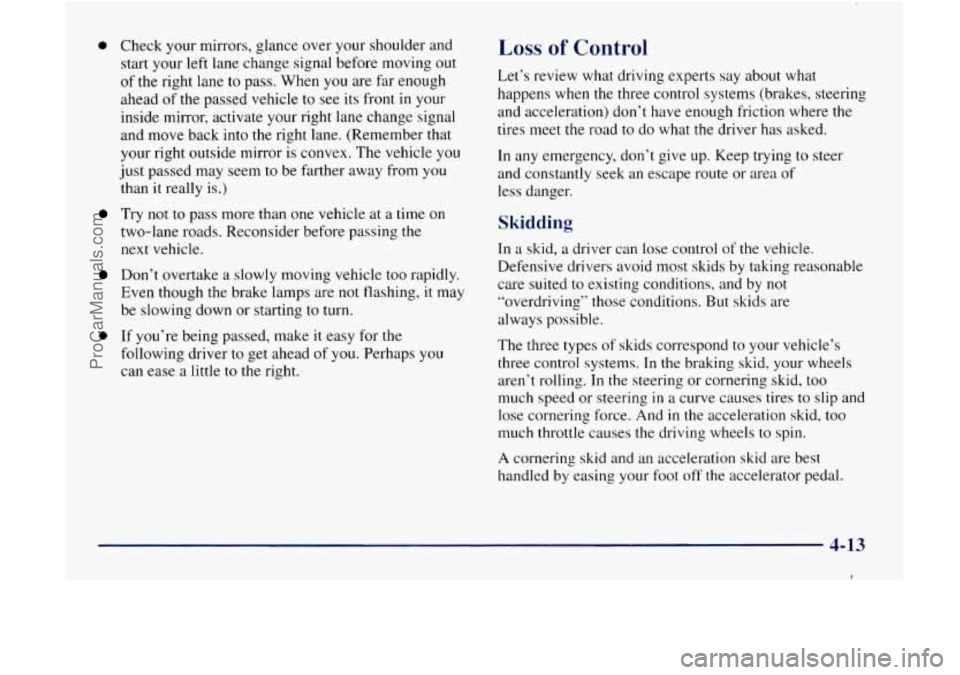
0 Check your mirrors, glance over your shoulder and
start your left lane change signal before moving out
of the right lane to pass. When you are far enough
ahead of the passed vehicle to see its front
in your
inside mirror, activate your right lane change signal
and move back into the right lane. (Remember that
your right outside mirror is convex. The vehicle you
just passed may seem to be farther away from you
than
it really is.)
Try not to pass more than one vehicle at a time on
two-lane roads. Reconsider before passing the
next vehicle.
Don’t overtake a slowly moving vehicle too rapidly.
Even though the brake lamps are not flashing, it may
be slowing down or starting to turn.
0 If you’re being passed, make it easy for the
following driver to get ahead of you. Perhaps
you
can ease a little to the right.
Loss of Control
Let’s review what driving experts say about what
happens
when the three control systems (brakes, steering
and acceleration) don’t have enough friction where the
tires meet the road
to do what the driver has asked.
In any emergency, don’t give up. Keep trying
to steer
and constantly seek an escape route or area of
less danger.
Skidding
In a skid, a driver can lose control of the vehicle.
Defensive drivers avoid most skids by taking reasonable
care suited to existing conditions, and by not
“overdriving” those conditions. But skids are
always possible.
The three types
of skids correspond to your vehicle’s
three control systems.
In the braking skid, your wheels
aren‘t rolling.
In the steering or cornering skid, too
much speed or steering
in a curve causes tires to slip and
lose cornering force. And
in the acceleration skid, too
much throttle causes the driving wheels to spin.
A cornering skid and an acceleration skid are best
handled by easing your foot off the accelerator pedal.
4-13
I
ProCarManuals.com
Page 176 of 386
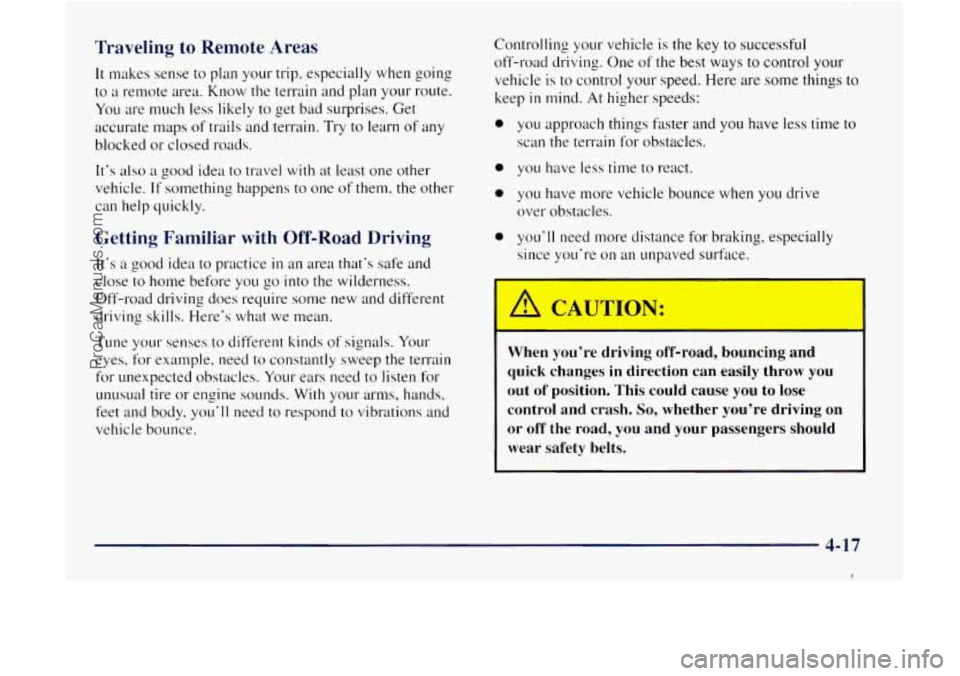
Traveling to Remote Areas
It makes sense to plan your trip, especially when going
to
a remote area. Know the terrain and plan your route.
You are much less likely to get bad surprises. Get
accurate maps of trails and terrain. Try to learn of any
blocked
or closed roads.
It’s also a good idea to travel with at least one other
vehicle.
If something happens to one of them, the other
can help quickly.
Getting Familiar with Off-Road Driving
It’s a good idea to practice in an area that’s safe and
close
to home before you go into the wilderness.
Off-road driving does require some new and different
driving skills. Here’s what we mean.
Tune your senses to different kinds of signals. Your
eyes, for example, need to constantly sweep the terrain
for unexpected obstacles. Your ears need to listen for
unusual tire or engine sounds. With your arms, hands,
feet and body.
you‘ll need to respond to vibrations and
vehicle bounce. Controlling
your vehicle is the
key to successful
off-road driving. One
of the best ways to control your
vehicle is
to control your speed. Here are some things to
keep
in mind. At higher speeds:
0 you approach things faster and you have less time to
scan the terrain for obstacles.
0 you have less time to react.
0 you have more vehicle bounce when you drive
over obstacles.
0 you’ll need more distance for braking, especially
since you’re on an unpaved surface.
A c. u7c-i:
When you’re driving off-road, bouncing and
quick changes in direction can easily throw you
out of position. This could cause you
to lose
control and crash.
So, whether you’re driving on
or off the road, you and your passengers should
wear safety belts.
4-17
I
ProCarManuals.com
Page 177 of 386
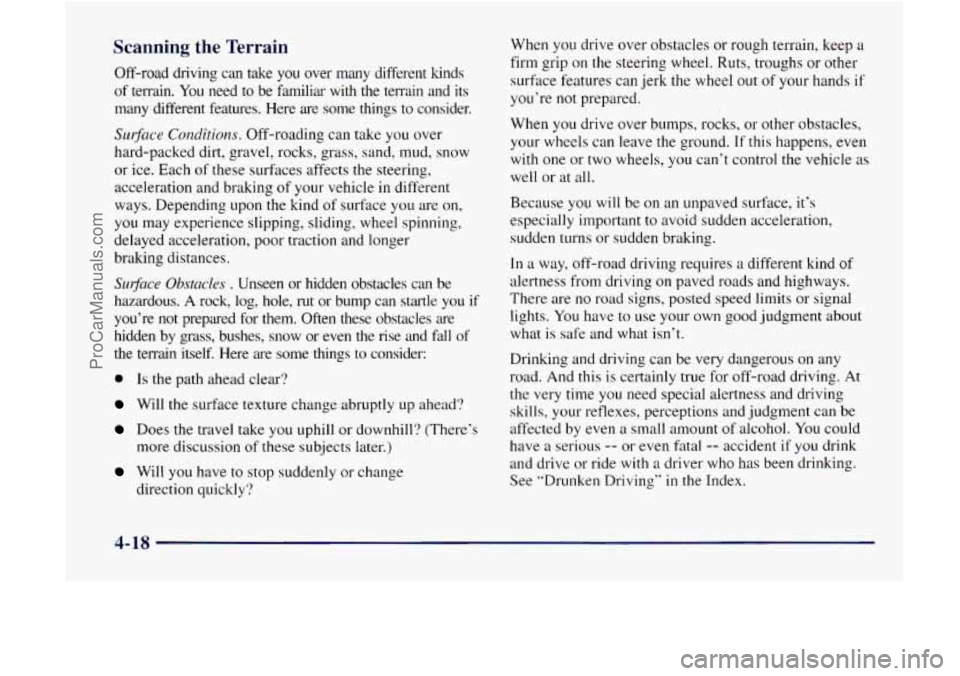
Scanning the Terrain
Off-road driving can take you over many different kinds
of terrain.
You need to be familiar with the telrain and its
many different features. Here are some things to consider.
S~lr$uce Conditions. Off-roading can take you over
hard-packed dirt, gravel, rocks, grass, sand, mud, snow
or ice. Each of these surfaces affects the steering,
acceleration and braking of your vehicle
in different
ways. Depending upon the kind of surface
you are on,
you may experience slipping, sliding, wheel spinning,
delayed acceleration, poor traction and longer
braking distances.
Su$ace Obstucles . Unseen or hidden obstacles can be
hazardous.
A rock, log, hole, rut or bump can startle you if
you're not prepared for them. Often these obstacles are
hidden by grass, bushes, snow
or even the rise and fall of
the terrain itself. Here are
some things to consider:
0 Is the path ahead clear'?
Will the surface texture change abruptly up ahead?
Does the travel take you uphill or downhill? (There's
more discussion of these subjects later.)
Will you have to stop suddenly or change
direction quickly'? When you
drive over obstacles or rough terrain, keep
a
firm grip on the steering wheel. Ruts, troughs or other
surhce features can jerk the wheel out
of your hands if
you're not prepared.
When you drive over bumps, rocks, or other obstacles,
your wheels can leave the ground.
If this happens, even
with one or two wheels, you can't control the vehicle as
well or at all.
Because you
will be on an unpaved surface, it's
especially important to avoid sudden acceleration,
sudden turns or sudden braking.
In a way, off-road driving requires a different kind of
alertness from driving on paved roads and highways.
There are no road signs, posted speed limits or signal
lights.
You have to use your own good judgment about
what is safe and what isn't.
Drinking and driving can be very dangerous
on any
road. And this is certainly true for off-road driving. At
the very time
you need special alertness and driving
skills, your reflexes, perceptions and judgment can be
affected by even
a small amount of alcohol. You could
have a serious
-- or even fatal -- accident if you drink
and drive or ride with a driver who has been drinking.
See "Drunken Driving"
in the Index.
4-18
ProCarManuals.com
Page 201 of 386
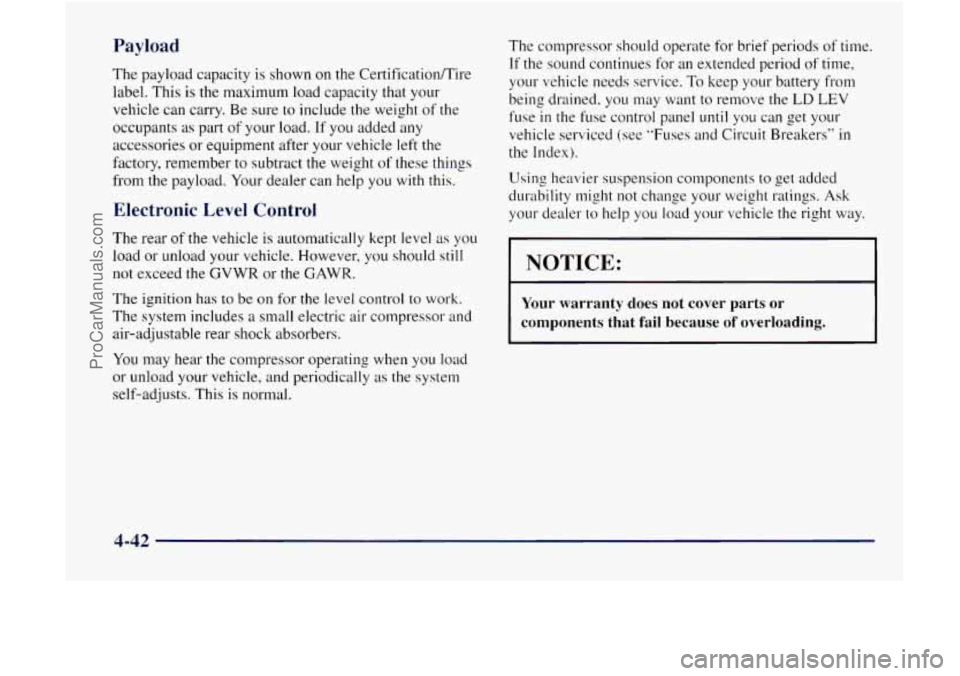
Payload
The payload capacity is shown on the CertificationRire
label. This is the maximum load capacity that your
vehicle can carry. Be sure to include the weight of the
occupants as part
of your load. If you added any
accessories or equipment after your vehicle left the
factory, remember to subtract the weight
of these things
from the payload.
Your dealer can help you with this.
Electronic Level Control
The rear of the vehicle is automatically kept level as you
load
or unload your vehicle. However, you should still
not exceed the
GVWR or the GAWR.
The ignition has to be on for the level control to work.
The system includes a small electric air compressor and
air-adjustable rear shock absorbers.
You may hear the compressor operating when you load
or unload your vehicle, and periodically
as the system
self-adjusts. This is normal. The compressor should operate for
brief periods
of time
If the sound continues for an extended period of time,
your vehicle needs service.
To keep your battery from
being drained. you may want to remove the
LD LEV
fuse in the fuse control panel until you can get your
vehicle serviced (see “Fuses and Circuit Breakers”
in
the Index).
Using heavier suspension components to get added
durability might not change your weight ratings.
Ask
your dealer to help you load your vehicle the right way.
NOTICE:
Your warranty does not cover parts or
components that fail because
of overloading.
ProCarManuals.com
Page 203 of 386

Every vehicle is ready for some trailer towing. If yours
was built with trailering options, as many are, it’s ready
for heavier trailers. But trailering is different than just
driving your vehicle by itself. Trailering means changes
in handling, durability and fuel economy. Successful,
safe trailering takes correct equipment, and
it has to be
used properly.
That’s
the reason for this part. In it are many
time-tested, important trailering tips and safety rules. Many
of these are important for your safety and that of
your passengers.
So please read this section carefully
before you pull a trailer.
If You Do Decide To Pull A Trailer
If you do, here are some important points:
0
0
There are many different laws, including speed limit
restrictions, having to do with trailering. Make sure
your rig will be legal, not only where you live but
also where you’ll be driving.
A good source for this
information can be state or provincial police.
Consider using a sway control if your trailer
will
weigh 2,000 lbs. (900 kg) or less. You should always
use a sway control if your trailer will weigh more
than
2,000 Ibs. (900 kg). You can ask a hitch dealer
about sway controls.
0
0
0
Don’t tow a trailer at all during the first 500 miles
(800 km) your new vehicle is driven. Your engine,
axle or other parts could be damaged.
Then, during the first
500 miles (800 km) that you
tow a trailer, don’t drive over 50 mph (80 km/h) and
don’t make starts at full throttle. This helps your
engine and other parts of
your vehicle wear in at the
heavier loads.
You should use DRIVE
(D) (or, as you need to, a
lower gear) when towing a trailer. Operating your
vehicle
in DRIVE (D) when towing a trailer will
minimize heat buildup and extend the life
of
your transmission.
Three important considerations have to
do with weight:
the weight of the trailer,
0 the weight of the trailer tongue
0 and the weight on your vehicle’s tires.
4-44
ProCarManuals.com
Page 238 of 386

I
4. Raise the vehicle by turning the jack handle to the
right. Raise the vehicle
far enough off the ground so
there is enough room for the spare tire to fit.
5. Remove all the wheel nuts and take off the flat tire.
6. Remove any rust or dirt
from the wheel bolts,
mounting surfaces and
spare wheel.
Rust or dirt on the wheel, or on the parts to
which it is fastened, can make the wheel nuts
become loose after a time. The wheel could come
off and cause an accident. When you change
a
wheel, remove any rust or dirt from the places
where the wheel attaches to the vehicle. In an
emergency, you can use a cloth
or a paper towel
to do this; but be sure to use
a scraper or wire
brush later, if you need to, to get all the rust or
dirt
off.
I
5-27
ProCarManuals.com
Page 262 of 386

A CAUTION:
Operating the engine with the air cleaner off can
cause you or others to be burned. The air cleaner
not only cleans the air, it stops flame
if the engine
backfires.
If it isn’t there, and the engine
backfires, you could be burned. Don’t drive with
it
off, and be careful working on the engine with
the
air cleaner off.
NOTICE:
If the air cleaner is off, a backfire can cause a
damaging engine fire. And, dirt can easily get
into your engine, which will damage it. Always
have the air cleaner in place when you’re driving.
Automatic Transmission Fluid
When to Check and Change
A good time to check your automatic transmission fluid
level
is when the engine oil is changed.
Change both the fluid and filter every
15,000 miles
(25 000 km) if the vehicle is mainly driven under one
or more of these conditions:
In heavy city traffic where the outside temperature
regularly reaches
90°F (32°C) or higher.
In hilly or mountainous terrain.
When doing frequent trailer towing.
Uses such as found in taxi, police or delivery service.
If you do not use your vehicle under any of these
conditions, change the fluid and filter every
50,000 miles (83 000 km).
See “Scheduled Maintenance Services’’ in the Index.
ProCarManuals.com
Page 277 of 386
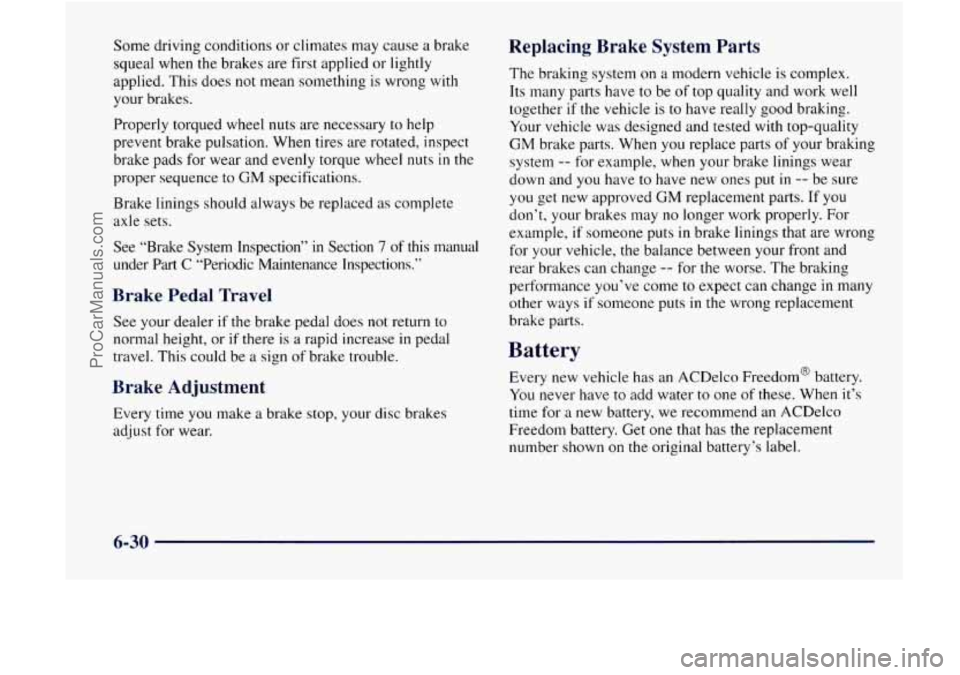
Some driving conditions or climates may cause a brake
squeal when the brakes are first applied or lightly
applied. This does not mean something is wrong with
your brakes.
Properly torqued wheel nuts are necessary to help
prevent brake pulsation. When tires are rotated, inspect
brake pads for wear and evenly torque
wheel nuts in the
proper sequence to
GM specifications.
Brake linings should always be replaced as complete
axle sets.
See “Brake System Inspection” in Section
7 of this manual
under Part
C “Periodic Maintenance Inspections.”
Brakc Jedal Travel
See your dealer if the brake pedal does not return to
normal height, or if there is a rapid increase in pedal
travel. This could be a sign of brake trouble.
Brake Adjustment
Every time you make a brake stop, your disc brakes
adjust for wear.
Replacing Brake System Parts
The braking system on a modern vehicle is complex.
Its many parts have to be
of top quality and work well
together
if the vehicle is to have really good braking.
Your vehicle was designed and tested with top-quality
GM brake parts. When you replace parts of your braking
system
-- for example, when your brake linings wear
down and
you have to have new ones put in -- be sure
you get new approved GM replacement parts.
If you
don’t, your brakes may
no longer work properly. For
example,
if someone puts in brake linings that are wrong
for your vehicle, the balance between your front and
rear brakes can change
-- for the worse. The braking
performance you’ve come to expect can change in many
other ways if someone puts
in the wrong replacement
brake parts.
Battery
Every new vehicle has an ACDelco Freedom@ battery.
You never have to add water to one of these. When it’s
time for a new battery, we recommend an ACDelco
Freedom battery. Get one that has the replacement
number shown on the original battery’s label.
6-30
ProCarManuals.com
Page 286 of 386

Q
+
I
!
When rotating your tires, always use one of the correct
rotation. patterns shown here.
After the tires
have been rotated, adjust the front and rear
inflation pressures as shown on the Certificationflire
label.
Make certain that all wheel nuts are properly tightened.
See “Wheel Nut Torque”
in the Index.
Rust or dirt on a wheel, or on the parts to which
it is fastened, can make wheel nuts become loose
after
a time. The wheel could come off and cause
an accident. When
you change a wheel, remove
any rust or dirt from places where the wheel
attaches
to the vehicle. In an emergency, you can
use a cloth or
a paper towel to do this; but be
sure to use a scraper or wire brush later,
if you
need to, to get all the rust or dirt off. (See
“Changing a Flat Tire”
in the Index.)
6-39
ProCarManuals.com
Page 308 of 386

Normal Maintenance Replacement Parts
Replacement part numbers listed in this section are
based on the latest information available at the time of
printing, and are subject
to change. If a part listed in this
manual is not the same as the part used in your vehicle
when it was built, or if you have any questions, please
contact your GMC dealer.
Thermostat
......................... 1255905 1
Oil Filter ............................... PF52
Air Cleaner Filter
...................... A1 163C
PCV Valve
.......................... CV746C
Automatic Transmission Filter Kit
...... 24200796
Spark Plugs
.......................... .41-932
Fuel Filter
............................. GF48 1
Front Windshield Wiper Blade
................ Trico (20 inched50.8 cm)
Backglass Wiper Blade . . Trico (14 inched35.6 cm)
Capacities (Approximate)
Cooling System* ............. 11.7 quarts (1 1.1 L)
Crankcase* ................... 4.5 quarts (4.3 L)
Automatic Transmission
(Drain and Refill)*
........... 5.0 quarts (4.7 L)
Differential Fluid ............................
Front ....................... 2.6 pints (1.2 L)
Rear ........................ 4.0 pints ( 1.9 L)
Fuel Tank ..................... 18 gallons (68 L)
A/C Refrigerant ........... 30 oz. or 2 lbs. (0.9 kg)
of R- 134a
*After refill, the level
must be checked.
6-61
ProCarManuals.com